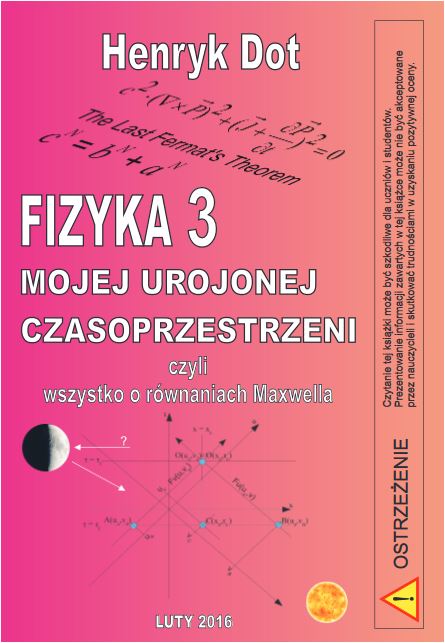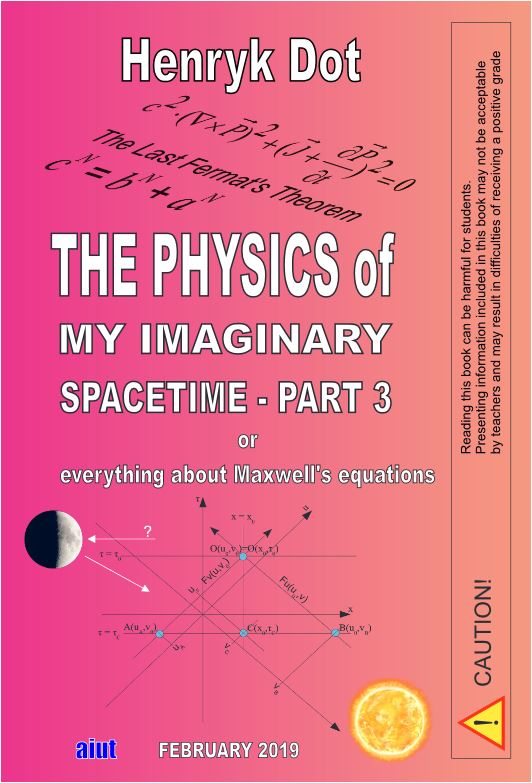★ HenrykDot.com
★
is the online companion to a series of books published by AIUT under the common main title
"Physics of My Imaginary Space-Time" by Henryk Dot.
is the online companion to a series of books published by AIUT under the common main title
"Physics of My Imaginary Space-Time" by Henryk Dot.
Home
Physics 3 - Maxwell
Note from the Author
Table of Contents
What is this book
Historical facts
New aspects
Fully erroneous
Incorrectly interpreted
Physics 3 - Chapter 1
Equations
Complex vectors form
The Most General form
The General Solution
Physics 3 - Chapter 2
Solutions
Initial conditions
Non-homogeneous equation
Solution for three-directions
The four laws
Physics 3 - Supplement
Fermat's proof
Beal's conjecture
Pythagorean triples
Inertial mass
Gravity constans big G
What does the Moon look at?
Physics 3 - Final notes
Final notes
Physics 4 - New book
Entry
Physics 3 - Maxwell
Note from the Author
Table of Contents
What is this book
Historical facts
New aspects
Fully erroneous
Incorrectly interpreted
Physics 3 - Chapter 1
Equations
Complex vectors form
The Most General form
The General Solution
Physics 3 - Chapter 2
Solutions
Initial conditions
Non-homogeneous equation
Solution for three-directions
The four laws
Physics 3 - Supplement
Fermat's proof
Beal's conjecture
Pythagorean triples
Inertial mass
Gravity constans big G
What does the Moon look at?
Physics 3 - Final notes
Final notes
Physics 4 - New book
Entry
Contact
email: henryk.dot(at)aiut.com
"Subject" should begin with
a digit corresponding to the day
of the week., e.g. Sunday=7
"Subject" should begin with
a digit corresponding to the day
of the week., e.g. Sunday=7
Books published by AIUT
are found in libraries according to the list of compulsory copies.
Second Edition of "Fizyka 3"
ISBN 978-83-926856-1-6

can be bought in Warsaw
in the Academic Bookstore
PW Publishing House
Noakowskiego street 18/20
and in Katowice
in the bookstore "Liber"
Bankowa street 11.
(area of Silesian University)
English edition of "Physics"
ISBN 978-83-926856-2-3

is also in libraries
and the distribution method should be asked wydawca@aiut.com.
|
We have announced in Introduction chapter – Item I.3 the derivation of complex vector
form for fields
and – this is presented below. | |
| , | (1.10) |
| we can differentiate both sides of both equations with respect to time “ ” | |
| , | (1.11) |
|
then use again (1.10) and insert into (1.11) , | |
| which results in: | |
| , . | (1.12) |
|
Since our initial form of equation (1.10) was assumed without considering field sources,
the values of
and
.
However, leaving these parts in the equations does not change their general features. The equations (1.12) have identical forms, variables and are separated and equations themselves are expressed in known form of wave equation. It can be noted that equations (1.10) exhibit different signs (+/-) but in (1.12) there is no difference anymore. This is no surprise and it was noted in my previous book (Fizyka 2), Opposite signs in equations (1.10) yield the same result as (1.12), since it only affects positive definition of vector cross product, and it is just related to either left or right handed coordinate system. But an interesting aspect appeared – how different forms of initial equations (1.10) can yield equal forms of final equations and when/how this equality happens? In order to find the answer to this question, the initial equations (1.10) were replaced by equations representing their sum and difference, and multiplied respectively by coefficients and . | |
| - sum | (1.13) |
- difference |
(1.14) |
| Reordering the equations to isolate variable we have: | |
| , | (1.15) |
| . |
(1.16) |
| Four new variables were created: | |
| , , and . | (1.17) |
| Coefficients and can be arbitrary chosen to reduce number of variables such that: | |
| . | (1.18) |
| This is possible when | |
| (1.19) | |
| therefore | |
| then . | (1.20) |
| The same relation is also achieved when: | |
| . | (1.21) |
| Therefore, we can arbitrary choose: | |
| or . | (1.22) |
| We have arrived then to the suggestion that four variables (as shown in (1.17) can be replaced with one which will be named as | |
| or , | (1.23) |
|
where can be any complex number.
It is beneficiary however to facilitate reverse conversion,
(i.e. to retrieve back values of
and
) to choose,
as either only real or only imaginary number. The value of is preferred in this book since equations are shorter and new variable is equal to: | |
| or . | (1.24) |
|
, and following relation applies: | |
|
|
(1.25) |
|
| |
| . | (1.26) |
|
As mentioned earlier this choice is just related to the choice of either
left or right handed coordinate system. | |
© 2020 Henryk Dot -
